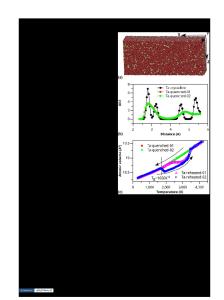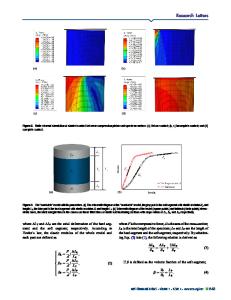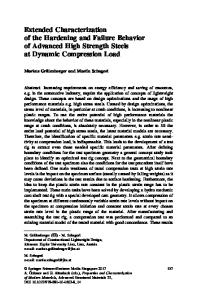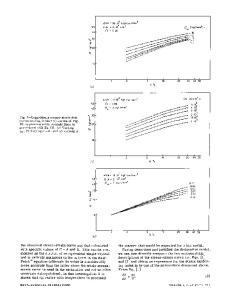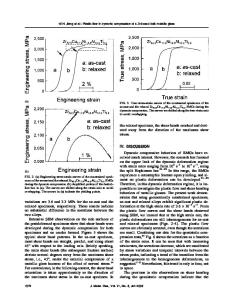Strain-rate dependence of hardening and softening in compression of a bulk-metallic glass
- PDF / 346,808 Bytes
- 4 Pages / 585 x 783 pts Page_size
- 72 Downloads / 941 Views
K.Q. Qiu School of Materials Science and Engineering, Shenyang University of Technology, Shenyang, Liaoning 110023, People’s Republic of China
H. Choo Department of Materials Science and Engineering, The University of Tennessee, Knoxville, Tennessee 37996; and Materials Science and Technology Division, Oak Ridge National Laboratory, Oak Ridge, Tennessee 37831
P.K. Liaw Department of Materials Science and Engineering, The University of Tennessee, Knoxville, Tennessee 37996 (Received 23 February 2007; accepted 02 July 2007)
We investigated the effect of strain rate on the plastic-flow stress of a Zr-based bulk-metallic glass in quasistatic compression. The results indicate that the plastic-flow stress is dependent on the strain rate: an increase in the strain rate leads to a decrease in the plastic-flow stress, and vice versa. However, simply loading, unloading, and reloading at a constant strain rate do not change the plastic-flow stress. This strain-rate dependence of the plastic-flow stress may be related to shear-banding operations.
At low temperatures (e.g., room temperature) and high strain rates, metallic glasses exhibit inhomogeneous deformation, which is limited to highly-localized narrow regions, i.e., shear bands.1,2 The formation of the shear bands substantially affects plastic-flow and fracture behaviors.2 Shear banding results in serrated plastic flows, which was widely observed in various loading modes,3–13 and the excessive propagation of individual shear bands causes premature fracture.2 Over decades, the shearbanding instability of metallic glasses has been well documented, and it has been attributed to the lack of work hardening.2,14 Recently, work hardening was surprisingly observed in a cyclic loading test of several bulk-metallic glasses (BMGs) using instrumented nanoindentation, and it was explained using a free-volume model, i.e., the free-volume accumulation and annihilation.15 This finding is opposite to the conventional viewpoints, i.e., the lack of working hardening in metallic glasses.2 It is relevant to investigate whether such work hardening exists under uniaxial loading conditions. The Zr52.5Cu17.9Ni14.6Al10.0Ti5.0 (at.%) BMG (Vitreloy 105) was used in the present work. It was pre-
a)
Address all correspondence to this author. email: [email protected] DOI: 10.1557/JMR.2007.0351 J. Mater. Res., Vol. 22, No. 10, Oct 2007
http://journals.cambridge.org
Downloaded: 18 Mar 2015
pared by arc-melting pure elements in a purified argon atmosphere, followed by casting in a water-cooled copper mold. The amorphous structure was confirmed by x-ray diffraction with Cu K␣ radiation. The compressiontest specimens have a dimension of 1.8 mm in height (h) and 3 mm in diameter (d), with an h/d ratio of 0.6. The low h/d ratio can avoid the premature fracture and develop a significant plastic deformation, facilitating an investigation of the plastic flow in uniaxial compression.14,16,17 A MTS 810 materials test system (Eden Prairie, MN) servohydraulic mechanical testing machine was used for the compr
Data Loading...




